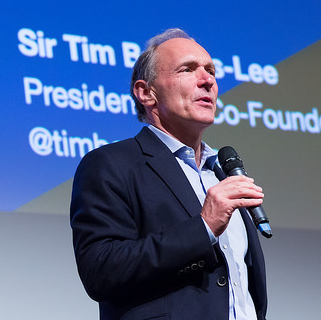Tim Berners-Lee, Inventor of the Web, Plots a Radical Overhaul of His Creation
Thirteen years ago the Queen of England dubbed Tim Berners-Lee, the creator of the worldwide web, a Knight Commander of the Order of the British Empire. Today he received what in the tech world counts as a much higher distinction: a Turing Award. The prestigious prize, presented each year by the Association for Computing Machinery, amounts to the Nobel Prize of computing and comes with a million dollars. Berners-Lee received the award for creating the technology that underpins the web 28 years ago. But he sees his creation as the work of countless other people—and believes that work is far from over. “I have to accept it on behalf of thousands of people who have helped make web standards and helped protest when net neutrality was threatened,” he says.
 Sir Tim Berners-Lee at the ODI Summit (CC BY-SA 2.0 UK)When Berners-Lee created the web, it was a decentralized platform. Anyone could publish a website and link to any other site. But as the web has grown from an obscure research-sharing tool for the scientific community into a global medium for commerce, communication, journalism, and entertainment, the power dynamics have shifted. Today, huge companies like Amazon, Facebook, Google, and Netflix dominate the web. These corporate giants enjoy an enormous amount of control not only over what people see and do online but over users’ private data. These days, Berners-Lee is working to reverse that trend as the co-lead of the Decentralized Information Group at MIT’s Laboratory for Computer Science and Artificial Intelligence (CSAIL).
Sir Tim Berners-Lee at the ODI Summit (CC BY-SA 2.0 UK)When Berners-Lee created the web, it was a decentralized platform. Anyone could publish a website and link to any other site. But as the web has grown from an obscure research-sharing tool for the scientific community into a global medium for commerce, communication, journalism, and entertainment, the power dynamics have shifted. Today, huge companies like Amazon, Facebook, Google, and Netflix dominate the web. These corporate giants enjoy an enormous amount of control not only over what people see and do online but over users’ private data. These days, Berners-Lee is working to reverse that trend as the co-lead of the Decentralized Information Group at MIT’s Laboratory for Computer Science and Artificial Intelligence (CSAIL).
On the better web Berners-Lee envisions, users control where their data is stored and how it’s accessed. For example, social networks would still run in the cloud. But you could store your data locally. Alternately, you could choose a different cloud server run by a company or community you trust. You might have different servers for different types of information—for health and fitness data, say—that is completely separate from the one you use for financial records. “It’s kind of like when you had floppy disks and you had one disk for the application and another the storage,” he says...
- Tags:
- Amazon
- America Online
- Association for Computing Machinery
- Compuserve
- Decentralized Information Group at MIT’s Laboratory for Computer Science and Artificial Intelligence (CSAIL)
- Federal Communications Commissions (FCC)
- Klint Finley
- Netflix
- open internet
- open source
- open technology standard
- Prodigy
- Solid
- Tim Berners-Lee
- Turing Award
- Login to post comments